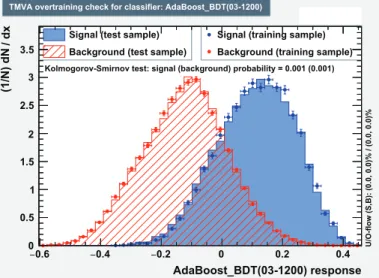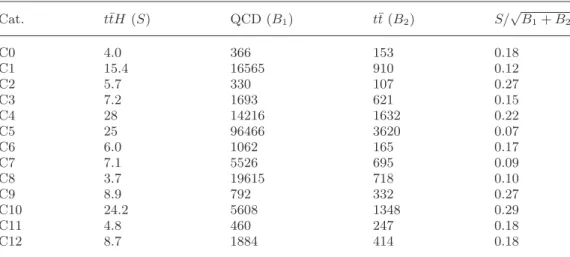DOI 10.1393/ncc/i2020-20077-4 Colloquia: IFAE 2019
IL NUOVO CIMENTO 43 C (2020) 77
t¯
tH associated production in the all-jets final state with the
CMS experiment
F. Iemmi(1)(2)(∗)(1) INFN, Sezione di Bologna - Bologna, Italy
(2) Dipartimento di Fisica, Universit`a di Bologna - Bologna, Italy received 8 June 2020
Summary. — This work summarizes the state of the art of t¯tH searches performed by the CMS experiment in the all-jets final state, namely the final state in which the Higgs boson decays to a b¯b pair and both the top quarks decay hadronically. New possible analysis strategies are also investigated, exploiting final states in the so-called boosted topology when at least one of the partons has a high Lorentz boost and its decay products are reconstructed in the detector as a single, wide jet.
1. – State of the art of t¯tH searches in the all-jets final state
In the standard model (SM) framework, the Higgs boson is predicted to couple to fermions with a Yukawa-like interaction, the coupling being proportional to the fermion mass. Since the top quark is the most massive fermion, it has the greatest coupling to the Higgs boson. Indirect measurements of this coupling have been performed in loop-level processes (such as Higgs boson decay to photons); however, a direct measurement of the top-Higgs coupling exploiting tree-level processes, such as the t¯tH associated production,
is crucial in order to exclude beyond-SM contributions which could enter the loops unno-ticed. Among all the possible final states for the t¯tH associated production, the all-jets
final state in which the Higgs boson decays to a b¯b pair and both the top quarks decay
hadronically has the highest branching fraction (≈25%). However, it turns out to be very challenging, having many particles that are difficult to identify (bottom quarks) and suf-fering from large contamination from the main background at hadron colliders, namely the QCD multijet production. The CMS Collaboration has performed a t¯tH analysis
in the all-jets final state [1] and has quantified the result in terms of the so-called sig-nal strength parameter μ, defined as the ratio of the observed cross section to the SM
(∗) E-mail: [email protected], [email protected]
2 F. IEMMI
predicted cross section. In this work, the kinematic differences between the t¯tH
produc-tion and the multijet producproduc-tion are exploited to discriminate signal from background through the matrix element method [2]. Specifically, events are assigned a probability density according to how compatible they are with signal and background processes. The measured value for the signal strength is found to be ˆμ = 0.9± 0.7 (stat) ± 1.3 (syst)
and, since it is compatible with zero, an upper limit has been set as well resulting in
μ < 3.8 (3.1) at 95% CL.
2. – New possible analysis strategies: the boosted topology
Due to the high energy of the LHC collisions, the production of particles with high Lorentz boost whose decay products are very collimated and can be collected as single, wide jets, often referred to as boosted jets, is likely. The CMS detector [3] is able to collect information about the boosted jets substructure: important quantities are the number of subjets, their invariant masses, transverse momenta, b-tagging discriminators, flavors and angles.
A study has been performed about the applicaton of boosted techniques to t¯tH events
in the all-jets final state. An optimal signal trigger has been chosen based on its effi-ciency on signal and QCD background; preselection cuts have been set in order to make this trigger fully efficient and enhance the signal-over-background ratio. Making strong use of multivariate techniques, it is possible to set up methods that exploit substruc-ture variables and global event variables to discriminate signal events from the dominant background of the search, namely multijet production and t¯t production. Boosted
de-cision trees (BDT) can be trained to identify boosted jets coming from Higgs bosons (Higgs candidates, HCs) and top quarks (top candidates, TCs); if no HCs are found, an additional BDT can be set up to identify t¯tH events in which the Higgs boson
de-cays to a pair of well resolved, b-tagged jets. The discriminator resulting from this last multivariate method is shown in fig. 1. Based on the Higgs boson decay topology, on the number of TCs and on the number of jets, t¯tH events can be split into 9 boosted
0.6 − −0.4 −0.2 0 0.2 0.4 AdaBoost_BDT(03-1200) response 0 0.5 1 1.5 2 2.5 3 3.5 dx / (1/N) dN
Signal (test sample) Background (test sample)
Signal (training sample) Background (training sample) Kolmogorov-Smirnov test: signal (background) probability = 0.001 (0.001)
U/O-flow (S,B): (0.0, 0.0)% / (0.0, 0.0)%
TMVA overtraining check for classifier: AdaBoost_BDT(03-1200)
Fig. 1. – Distribution of the BDT discriminator used to identify t¯tH events containing a resolved Higgs. A good discriminating power between signal and background events is obtained.
t¯tH IN THE ALL-JETS FINAL STATE WITH THE CMS EXPERIMENT 3
TableI. – Expected yields corresponding to the integrated luminosity of the 2016 data taking period (35.9 fb−1). Signal (t¯tH) and dominant background (QCD and t¯t) yields are reported, as well as the significance of each category computed as signal over the square root of back-ground. Boosted Higgs categories run from C0 to C8, while the remaining ones are resolved Higgs categories. Cat. t¯tH (S) QCD (B1) t¯t (B2) S/ √ B1+ B2 C0 4.0 366 153 0.18 C1 15.4 16565 910 0.12 C2 5.7 330 107 0.27 C3 7.2 1693 621 0.15 C4 28 14216 1632 0.22 C5 25 96466 3620 0.07 C6 6.0 1062 165 0.17 C7 7.1 5526 695 0.09 C8 3.7 19615 718 0.10 C9 8.9 792 332 0.27 C10 24.2 5608 1348 0.29 C11 4.8 460 247 0.18 C12 8.7 1884 414 0.18
Higgs categories and 4 resolved Higgs categories, resulting in the expected yields and significances reported in table I.
3. – Conclusions
t¯tH events in the all-jets decay channel offer a unique possibility to study the
top-Higgs Yukawa coupling in a fully reconstructed final state. The boosted approach, based on the presence of wide jets, is complementary to the ongoing CMS analyses and can be used to compute an upper limit on the signal strength parameter μ, possibly exploiting the full Run 2 dataset (2016 + 2017 + 2018 data taking periods). A combination between resolved and boosted analyses may also be feasible.
REFERENCES
[1] CMS Collaboration, JHEP, 06 (2018) 101. [2] Wertz S., J. Phys.: Conf. Ser., 762 (2016) 012053. [3] CMS Collaboration, JINST, 3 (2008) S08004.

